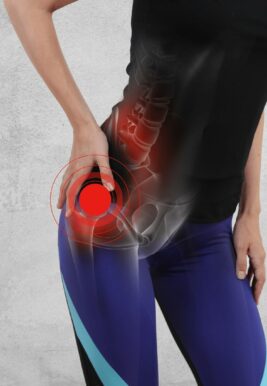Hip Assessment

Learn
The Hip Joint
The hip joint is a deep ball and socket joint comprised of the convex femoral head and the concave acetabulum of the pelvis. Similar to the glenohumeral joint, the acetabulum has a glenoidal lip or labrum around its edges for extra stability.

Epidemiology
It is estimated that around 10% of the general population suffers from some sort of hip complaint (Birrel et al. 2005). In the athletic population (mainly club football) hip/groin injuries accounted for 4-19% of all injuries (Weir et al. 2015). The most common conditions, which we will cover in more detail in this course are osteoarthritis, labral tears due to femoroacetabular impingement (FAI), and greater trochanteric pain syndrome (GTPS) also known as gluteal tendinopathy.
Course
According to the Dutch study by Picavet et al. (2003), around 28% of people with hip or knee pain have continuous mild pain and mild pain is recurrent in 46% of people with either a hip or knee complaint.
Lievense et al. (2007) followed 224 patients age ≥50 with hip pain over a period of six years and assessed disease progression and incidence of total hip replacement at three and six years. After three years, 15% of patients showed disease progression and 12% underwent hip replacement surgery. Disease progression almost doubled at the second follow-up (28%) and 22% had received a hip replacement.
The individual prognosis for the specific pathologies is discussed in the next units.
Prognostic factors
According to a review by Artus et al. (2017) the following factors are related, but not limited to, the course of hip pain:
- widespread pain
- high functional disability
- somatization
- high pain intensity
- presence of previous pain episodes
Red flags
Next to the general red flags that should be asked in any case, specific red flags in the hip joint can be:
1) Region-specific red flags:
- Again fractures. This is especially important in the elderly population where hip fractures accounted for up to 14% of all fractures (Burge et al. 2007, Ensrud et al. 2013)
- Avascular femoral head necrosis, which manifests as intermittent groin pain that increases with activity. Usually the case in prolonged use of corticosteroids (Barille et al. 2014)
2) Tract anamnesis:
- Gastrointestinal tract: this visceral pain is mostly deep aching, gnawing, vague, or deep grinding. Conditions include GI bleeding, epigastric pain, constipation, obturator or psoas abscess, appendicitis.
Furthermore, you should not forget to rule out SI Joint or lumbar spine involvement in case of a hip complaint. This is because the hip receives innervation from spinal segments L2-S2. Therefore it is a common site for referred pain from these structures. Check the “further reading” section and the bottom for literature on the topic.
LEVEL UP YOUR DIFFERENTIAL DIAGNOSIS IN RUNNING RELATED HIP PAIN – FOR FREE!

Basic Assessment
Depending on the outcome, your basic assessment can give you the following info:
1) Limitations in range of motion and their end-feel can guide structural assessment (e.g. bone to bone=osteoarthritis, empty=tendinopathy due to pain)
It’s best to start with Active Range of Motion Assessment:
Standard values for the range of motion in different directions are as follows:

AROM assessment is then typically followed by Passive Range of Motion Assessment (PROM). PROM assessment in the hip joint is also used as part of the diagnostic criteria for hip osteoarthritis, where a marked decrease increases the likelihood of OA.
During PROM assessment, it’s important to compare the range of motion as well as the end-feel of the affected hip with the unaffected side.
Muscle strains or sprains are common in the hip and groin region, especially in athletic populations. In the following two videos, you will see how you can stress the muscles around the hip joint to possibly identify them as a source of nociception as well as a video on the differentiation of groin pain in athletes.
Specific Pathologies in the Hip
There are several pathologies that are commonly seen in the hip area. For more information, click on the respective pathology (content will be added in the near future):
- Muscle Contractures
- Leg Length Difference
- Hip Microinstability
- Femoroacetabular Impingement (FAI) / Labrum Tears
- Tendinopathy
- Deep Gluteal Syndrome
- Ischiofemoral Impingement
- Osteoarthritis of the Hip
References
Accredited online physiotherapy courses
- Built by the experts at Physiotutors
- Best price per CEUs/CPD Points
- Accredited in the Netherlands, Belgium, Germany, USA, UK, & Australia
- Learn anywhere, any time, and at your own pace!







